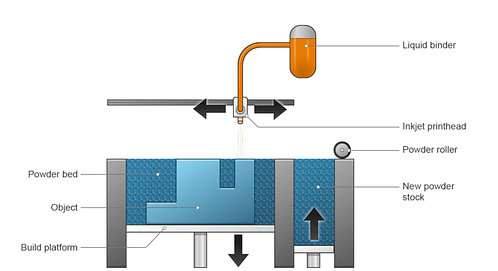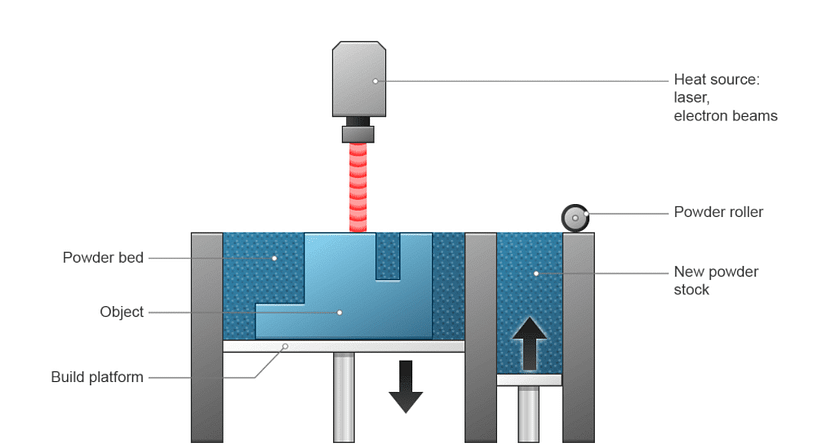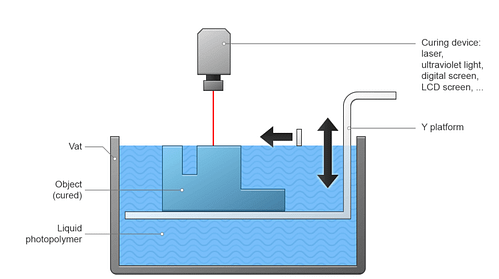Additive Manufacturing (AM) is a technology where the 3D objects are created by adding multiple layer-upon-layer, it could be plastic, metal, concrete or human tissue. AM is also know as 3D printing
Additive manufacturing encompasses various technologies in it, that include rapid prototyping, 3D printing, layered manufacturing, additive fabrication and Direct Digital Manufacturing (DDM).
AM process requires, 3D modeling software (Computer Aided Design or CAD) to design the model, layering material as raw material and Machine equipment (3d printer) to print the object. The layering material could be sheet material, liquid or powder.
Application of Additive Manufacturing is limitless. Early use of AM was in the form of Rapid Prototyping focused on preproduction visualization models. However, recently, it is widely used to fabricate end-use products in different industry, like, dental, medical implants, automobiles, aircraft and even fashion products.
3d printing and additive manufacturing facts:
Why AM over traditional subtractive technique?
- Cheap Manufacturing:- Cost cutting upto 70%.
- Quick Production:- Speed up production and prototyping by 70-80%.
- Less waste:- With the help of 3D printing technology / AM, the finished 3D printed product can be up to 60% lighter with less wastage
- Sustainability: – Eco friendly and Less waste compared to traditional manufacturing methods
- Open door to New complex shapes and structures that is not possible with traditional process
Additive manufacturing Process :
Before moving to additive manufacturing types, let’s quickly understand the process. In AM object is building layer-upon-layer of material, usually we use ceramic or metal powder, on a build platform until final product is finished. Finally, the layers are hardened by using heat, curing agents or lasers.
Since this method is additive, there’s less waste compared to traditional subtractive manufacturing, and therefore low costs.
Types of additive manufacturing
Here are the main types of additive manufacturing process with it’s, pros and cons, so that you can choose the best suitable method for your business.
- Binder Jetting
- Directed Energy Deposition (DED)
- Material Extrusion
- Powder Bed Fusion (PBF)
- Sheet Lamination
- Vat Polymerization
- Material Jetting
1. Binder Jetting
Binder jetting is most common additive manufacturing types, it is also known as material jetting or inkjet powder printing.
This Binder jetting is similarly to our regular office printer, except it prints 3D objects. In binder jetting we use adhesive Instead of ink, binder jetting includes jets that eject adhesive into a powder material. The print head moves horizontally and vertically, putting down a new layer to build the final product.

2. Directed Energy Deposition (DED)
In Directed energy deposition (DED) we use welding principles to create 3D objects. In DED we usually use material like metal wire or metal powder which is melted by a focused energy source like an electron or laser beam. The liquid material is precisely poured onto the build platform, where it quickly hardens and forming a layer. This process repeats until the complete object is finished.
We can use Direct Energy deposition for repairing item as well. Additionally, in this we can use multiple materials in a single printing process.
3. Material Extrusion
The material extrusion process is similar to a hot glue gun. In the Material Extrusion process, we feed the material into the printer from a coil. The tip of the nozzle heats and melts the material out save as glue gun. The extrusion liquid material is then placed layer by layer on the build platform, where it cools and solidifies, forming the final object.
The material extrusion process is inexpensive compared to other Additive manufacturing techniques because of its low-cost equipment and materials.
The material extrusion process has its own limitation along with benefits, in this, we cannot use high-density material like metal, as heating elements are not powerful enough to melt metal, it is limited to plastic or low melting point polymers – which may not be durable enough for an application like tooling and fixturing.
4. Powder Bed Fusion (PBF)
Powder bed fusion also known as electron beam melting (EBM), starts with a large bed of powdered material, typically metal, plastic, metal, sand, or ceramic powders mixed with sand.
The powder is selectively fused together using a electron or laser beam. Once a layer of material is fused, the working platform moves down, and the new layer is built on top using the same process.

Object created by PBF are stronger compared to some other types of additive manufacturing, however the process is complex compared to other, moreover it is difficult to maintain a clean working environment as it requires a bed of powder.
Below are the different types of Powder Bed Fusion methods:
- Selective Laser Sintering (SLS)
- Selective Laser Melting (SLM / Direct Metal Laser Sintering (DMLS)
- Multi Jet Fusion (MJF) by HP
- Electron Beam Melting (EBM)
Selective Laser Sintering (SLS):
SLS (Selective Laser Sintering)3D printing technology originated in the late 1980’s at the University of Texas at Austin. Over the years, this technology has experienced remarkable advancement. Basically, the process uses lasers to sinter powdered material layer-by-layer to create final solid structure. The final product, rendered enveloped in loose powder, which later cleaned with brushes and pressurized air.
The main materials used in the SLS 3D printing process include Alumide (a blend of gray aluminum powder and polyamide), polyamide (Nylons), and rubber-like materials. Nylons are durable and strong but do feature some flexibility, making them excellent for brackets, snap fits, clips, and spring features. In this process, designers should take the susceptibility for warping and shrinkage of thin parts into consideration during the conceptual and designing phase.
Selective Laser Melting (SLM):
SLM (Selective Laser Melting)also called DMLS (Direct Metal Laser Sintering), however there is minute differences between the two processes:
SLM (Selective Laser Melting) is exclusively used to produce metal parts. The material we usually use in this is aluminum, it can be used to create light, strong spare parts and prototypes as per required model.
DMLS (Direct Metal Laser Sintering) sinters the powders and is restricted to alloys, including titanium-based alloys. These methods require additional support to compensate for the high residual stress and to limit the occurrence of distortion. Applications include dental industries, jewelry, spare parts, and prototypes.
The basic difference between two is, in the sintering metal powder do not fully melt, but heat it to the point that the powder can fuse together on a molecular level, and with sintering, the porosity of the material can be controlled.
However, “Selective Laser Melting, on the other hand, powder is actually melted into a homogeneous part. To nutshell it, if you’re working with an alloy, you’ll go DMLS; but if you’re working with, pure metal titanium, you’ll go with SLM.”
Multi Jet Fusion (MJF) by HP
The Multi Jet Fusion (MJF) 3D printing technique differs from the aforementioned methods in MJF an inkjet array is used to apply fusing and detailing agents, which are then fused by heating the elements into a solid layer. Here, no laser is involved. Detailing agents are jetted around contours to improve part resolution thus here you would get the possibility for lifelike object production.
5. Sheet Lamination (Laminated object manufacturing -LOM)
Sheet lamination is also known as ultrasonic additive manufacturing (UAM) or laminated object manufacturing (LOM) – is an additive manufacturing process that stacks thin sheets of material and bonds them together through ultrasonic bonding, welding or brazing. As the layers stack up, the object takes shape as per the required 3D model.
Once all the layers are laminated and stacked, a laser cutter or CNC machine removes excess material, creating the object’s final form.
Since it works in multiple layers, sheet lamination allows manufacturers to layer various materials, with the option of multi color, and at a much lower cost than some other additive manufacturing processes.
While sheet lamination is relatively inexpensive, however it does require some post-processing, which can be time-consuming and tedious. In this process you’re also limited to materials that can come in sheets, such as paper, plastic, and metal. Since objects need to be trimmed once lamination is complete, so some waste is involved in this additive manufacturing process.
Vat Polymerization
Vat polymerization is similar to powder bed fusion technology, except instead of a bed of powder, it uses a material usually photopolymer resin, which is hardened in layers by an UV (ultraviolet) laser. Once a layer is complete, more resin is added, and the next layer gets built same as powder bed fusion. This process goes on continues until the object is complete.
Although this is expensive due to high cost of resin, vat polymerization can construct objects quickly while providing a good finish and high level of accuracy.

Despite its benefits, vat polymerization manufacturers are limited to using photo-resin materials and are required to perform post-processing. The printed objects need to be removed from the resin and cleaned up before they’re ready for use or production.
Material Jetting
Similar to binder jetting, material jetting build the product layer by layer. However, instead of layering adhesive on a bed of powder, material jetting melts wax-like materials and precisely deposits droplets onto the build platform. As the layers build up, the object takes shape as per desired product
Many manufacturers utilize material jetting because of its high accuracy surface finish and relatively inexpensive. Unfortunately, material jetting is limited to using only wax-like materials, which limits its possibility to extend the usage towards other material. It also takes longer to build objects because it builds one droplet at a time and fragile.
Which Type of Additive Manufacturing Is Right for Your next project?
Before selecting an additive manufacturing method, it’s important to think about the requirement and usage as per your project. Are you looking for a more budget friendly option, or do you need to use stronger build materials for your next project? Whatever /whenever your need, there’s an additive manufacturing process to benefit your production. Keep following Futuretechverse for more updates on 3D Printing and future technology
Have you checked our latest blog where 3D printing saves the life of women, visit here for more details.
What are the benefits of additive manufacturing?
Additive manufacturing offers several benefits, including the ability to create complex geometries that would be difficult or impossible to produce using traditional manufacturing methods. It also enables faster prototyping and customization, reduces waste, and can be more cost-effective for small production runs.
What materials can be used in additive manufacturing?
Additive manufacturing can be used with a variety of materials, including plastics, metals, ceramics, and even food and living tissues. The specific materials that can be used depend on the type of additive manufacturing process being used.
What industries use additive manufacturing?
Additive manufacturing is used in a wide range of industries, including aerospace, automotive, medical, consumer products, and architecture. It is particularly useful for prototyping and producing customized or low-volume parts.
Can additive manufacturing be used for large-scale production?
While additive manufacturing is often associated with prototyping and low-volume production runs, it can also be used for large-scale production. However, the economics of using additive manufacturing for large-scale production may depend on the specific application and the materials being used.

